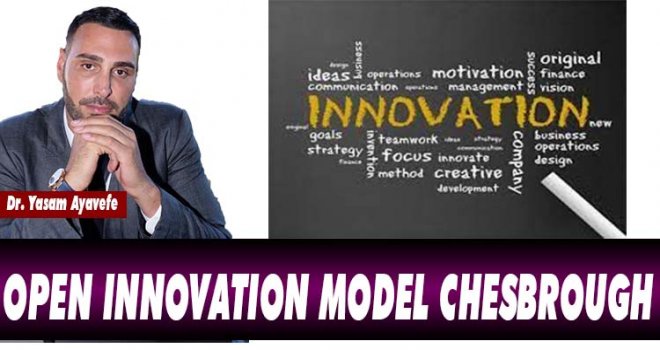OPEN INNOVATION MODEL CHESBROUGH

Open innovation, which was popularized in 2003, is generating a lot of enthusiasm today.
Surveys confirm that one in two companies no longer confines innovation to R&D centers, drawing outside inspiration or technologies as articles in academic journals proliferate.
However, there are many questions that open innovation raises.
There are critical analyzes of the fundamentals of open innovation, rightly so. This model has been an unprecedented response to unique changes in business.
However, innovation has become a competitive weapon that should be preferred more than ever. But this so-called innovation is not always based on detailed historical analysis.
Let's look at the achievements of Intel (microprocessor), Sony (transistor radio), or Microsoft (operating system). To be successful, the company does not necessarily have to be at the source of an innovation.
For more than two decades, we have recognized that upstream integration of leading users can make it possible to anticipate future needs.
Should we therefore reject the open innovation model? Is it right to ignore the author's contribution? We don't think so.

We think that, with a few adjustments and extensions, the Open Innovation Model can provide both a useful and stimulating representation for the practitioner and the way in which the innovation process of particular firms is organized.
The rapid success of the proposed model, especially for practitioners, aroused admiration.
Just at a time when open innovation was revolutionizing applications in the software space, mentioning the term probably fostered the spread of ideas.
However, if we carefully examine the location of users, the way teams work, and the intellectual property mechanisms specific to each situation, we see that the word "open" is not entirely justified.
Therefore, it is necessary to examine in detail what should be understood by clarity.

What is meant by the word "open"?
The free software community has largely offered an alternative to proprietary logic in the computing world.
A new type of license has been defined, in which the owner of the source code gives users the right to copy, distribute and modify it.
To guarantee these levels of freedom, this software is "protected" by "copyleft", which prohibits hiding the source code of the software and all derivatives. Thus, there is a collective creation freely shared in Open Source.
The workings of this community have definitely broken with commercial logic, as every developer has given up on their copyright and hence the innovation rent associated with it. The logic of exchange between developers is the logic of gifts.
The Open Source world has one important feature. Developers are also users. They are both the initiators of the innovation project (they indicate problems, needed improvements, etc.), the co-creators (they participate in problem solving) and the users.
Therefore, it must be recognized that the Open Source community is based on a strong concept of openness. Because any developer can use a resource without authorization to create another resource that they can't control later on.
A resource is open from the moment a particular player can acquire it or use it under specified conditions.
The owner of a resource may decide, under reasonable circumstances, to offer it to one actor and not to another. There is a discriminatory character here that we do not find in Open Source.
The innovation of the open model is used to manage these rights, which is part of traditional operational logic. It derives from the strategic status given to intellectual property rights rather than mechanisms and provisions.
The inside-out and outside-in distinction on which open innovation is based is not marked in Open Source. Each member is both a user and a knowledge producer for the same innovation.
Similarly, the transfer of intellectual property rights gives rise to a monetary counterpart in Open Innovation, where Open Source is based on a gift logic. The use of these two dimensions shows that it is based on a fairly narrow aperture design.
The Open-Source community operates through free allocation processes with obligations to disclose improvements made to other members.
On the contrary, studies on the Open Innovation Model conducted on industrial firms are more or less restrictive in terms of obtaining and transferring licenses. But they insist that it be paid.
These acquisition and disposal practices do not require any special development here.
This corresponds to the most emphasized situations on the Open Innovation Model. Open Innovation seems to be becoming more systematic within firms. Some companies make selling obsolete technology a priority.
In these cases, this takes place within closed communities, although openness is aimed at a range of identified and chosen partners.
Dr.Yaşam Ayavefe
-
 Küfür ediyor ve siyasi yorumlarıyla tepki çekiyor: Musk'ın sohbet botu Grok nede..
Küfür ediyor ve siyasi yorumlarıyla tepki çekiyor: Musk'ın sohbet botu Grok nede..
-
 Arıklı’dan 'Evden Eve Fiber Projesi' açıklaması: Bu bir devlet projesidir, engel..
Arıklı’dan 'Evden Eve Fiber Projesi' açıklaması: Bu bir devlet projesidir, engel..
-
 İEZB Başkanı Serkan Kırmızı’dan KIB-TEK’e Sert Tepki: Bu Bir Enerji Beka Sorunud..
İEZB Başkanı Serkan Kırmızı’dan KIB-TEK’e Sert Tepki: Bu Bir Enerji Beka Sorunud..
-
 Asgari Ücret Saptama Komisyonu 16 Temmuz’da toplanacak
Asgari Ücret Saptama Komisyonu 16 Temmuz’da toplanacak
-
 Othello Folklör Master ekibi Bosna'daydı
Othello Folklör Master ekibi Bosna'daydı
-
 Kaçak taksiye 86 bin 938 TL ceza!
Kaçak taksiye 86 bin 938 TL ceza!
-
 Cevdet Yılmaz: Fiber altyapı projesi bir yılda tamamlanacaktır!
Cevdet Yılmaz: Fiber altyapı projesi bir yılda tamamlanacaktır!







